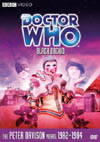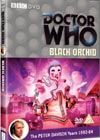DVD Extras include:
"Black Orchid" seems to believe that it is a 1925 period murder mystery, but as we shall see, there is very little mystery in the piece. Although featuring many wonderful ideas and enjoyable scenes, one is easily left wondering, "Where's the story?"
The Mostly Pleasant MeanderingOpening with a lacklustre and somewhat confusing sequence of the catalyst murder that should, according to formula, drive the story forward, this event instead is left so far removed from the concerns of all the rest of the characters we see throughout the first episode that it has virtually no impact beyond being a limp opening.The rest of the characters are occupied mostly with enjoying themselves, rather nicely inviting the audience to do so with them. The series regulars are introduced quite well, and the TARDIS gets its due with a proper materialization to start things off and a scene in the interior console room juxtaposed with the exterior at the train station. The scanner screen gets its due as well. All you could hope for, in theory. Dialogue during these scenes is not great however, and the characters don't quite seem at their best. Tegan revealing that she's no longer desperate to get back to her stewardess job is a nice touch, but Adric's curiosity about railways doesn't do anything for the audience, unlike a similar scene with Jamie in "The Evil of the Daleks" (story no. 36) which was at least injected with a good dose of humour. Adric and Nyssa would have done much better asking Tegan to explain some of the rules of cricket, so that members of the audience like myself who need a refresher might have a chance at following the game.
Even more refreshing is what happens later. Instead of holding on to the fear of letting the locals know who he and his friends really are, the Doctor lets the truth come out, using this to help clear his name, albeit with enough nervous reluctance to suggest he's overcoming an old issue. Maybe he is. Good for him. And so the TARDIS is explained and demonstrated yet again in episode two, in greater detail, with another satisfying "short hop" materialization to boot. Thankfully, Sir Robert Muir is a much more open-minded, well-rounded, and enjoyable character than the usual morons the Doctor often tried to convince in Malcolm Hulke scripts in the Jon Pertwee era, and the very kind of character that was so badly needed in "The Time Meddler" (story no. 17). He even gets to tour the TARDIS interior with some of his men, a wonderful touch that seemed to be previously unthinkable in less modern historicals. Excellent. But still, there is hardly enough "story" here to make this a good adventure to introduce new viewers to Doctor Who. And the popular JNT idea of the cutaway takes its toll on this story - putting an unrelated cutaway scene between people entering the police box exterior and seeing the impossible interior of the TARDIS should be absolutely banned on Doctor Who. Worse, the entire threat in this story seems to be based on cutaway scenes.
A lengthy section of visiting and friendly discussion then ensues, while the idea of Nyssa having a double named Ann Talbot is explored. Contrary to what one might expect, no real mistaken identity plot is made out of this. One is still wondering what kind of story might kick in, as Sir Robert Muir casually mentions the Master, a.k.a. the other Doctor. Even after diffusing the remark, one is left wondering how interesting this story might become if the Master had somehow managed to involve himself in the heart of it.
Intercut with all of this throughout episode one are snippets of our gargling villain's feet, as he interacts quietly with a silent South American, a dead body or two, and the Doctor's masquerade costume. Not very effective.
Where the Deuce has the Mystery Hidden Itself?Mysteries typically work when an event triggers a line of questions and investigations to which everyone desperately wants answers. Typical murder mysteries involve an exploration of the life of the deceased, in attempts to reconstruct his or her final moments, or to find the killer's motive amongst the deceased's relationships. Of course, if human beings knew how to access their caring for people as much before they lose them as they do afterwards, we could have all that fascinating exploration without the grisliness of murder polluting our stories."Black Orchid", however, gets the whole dynamic completely reversed, giving us the murders while failing to trigger much of an investigation. Until the cliffhanger comes along, there isn't a single vocal character on screen who notices, cares, or draws any attention to the man who dies in the opening sequence. Writer Terence Dudley is relying on the audience to care all on its own. Sorry, murder mystery is not my particular cup of tea, and Digby is more interesting alive. He needs at least to be alive in someone's memory.
At last the stakes seem to be raising themselves during an action beat, and the Doctor has some critically good things to do in making the outcome better. Well done.
FIRST IMPRESSIONS - IS IT OVER?On first viewing, I was starting to like Black Orchid and get into it near the end of Part Two. George Cranleigh had an interesting backstory involving various tribes in South America and the bizarre flower they worshipped. They obviously needed to be sorted out, and the Master was probably involved with them somehow. I was full of anticipation for the South American section of the story to unfold, along with the deeper mysteries of the piece.The Doctor was given a book and opened it to the first page. I couldn't read what was written there, but it must have been profound, because it triggered Part Two's cliffhanger. Next week, I tuned in eagerly for Part Three and was most baffled and upset to be watching something called "Earthshock", which didn't seem bad at all in itself, but I didn't want to see it yet if it carried on from Parts Three and Four of "Black Orchid" which I'd somehow missed. I wondered if TVOntario had got their tapes mixed up and broadcast the wrong episode. Only when the season's broadcasting continued with Part Two of "Earthshock" did I look back at "Black Orchid" and realize that I had actually seen all there was of it. My first experience of a Doctor Who story that was NOT four episodes long. Unforgettable.
Production ValuesRoger Limb does the incidental music in this one, beginning the run of his least successful Doctor Who work. Starting off by reusing not the interesting, emotional, recognizable bits of his score from "Four to Doomsday" (story no. 118) but rather the more random, unnotable links and cues, he embellishes these with added high pitched instrumentation that adds little weight to what was already a pretty airy story. The most stand-out element is a three note phrase played with a high piano sound, the last two of those three forming what I call the "semitone drop", also known as the Achilles' Heel of Roger Limb Doctor Who music.To do a semitone drop, basically you play any note very briefly, and then drop one semitone to hold the note below it for as long as suspense is necessary. The higher your pitch, the sillier it sounds. Bill Murray made fun of something very similar on the piano in "Ghostbusters", commenting that ghosts hate that. So do I. The cliché is perhaps most at home in the murder mystery setting, hence it isn't too out of place here, and isn't marring a classic in this case. But long story short, "Black Orchid's" incidental score is nothing to write home about. Semitone drops abound all through the uninspired cues, and it never quite makes itself memorable otherwise. By contrast, the 1920's dance source music tracks from "Debroy Somers' Savoy Orpheans" and "Irving Berlin" easily steal the show musically and create a fun mood for the party scenes, aided by all the excitement Tegan shows for "The Charleston" in particular. Not the best technical recordings, unfortunately, but great stuff nonetheless. The acting is of a high calibre in this one, with particularly strong performances from Michael Cochrane as Charles Cranleigh, Barbara Murray as Lady Cranleigh, and Moray Watson as Sir Robert Muir. Sarah Sutton is excellent as ever as Nyssa, and great to see in the decidedly different characterization of Ann, but Ann's portrayal gets a bit theatrically phoney when the script turns her into a wimp - the style of the times more than anything else.
International Titles:Deutsch: "Die schwarze Orchidee"Magyar: "Fekete orchidea"Français: (L'Orchidée Noire)Русский: "Чёрная орхидея"This story has become available on DVD and VHS video.
Comments on this article are welcome. You may contact the author from this page:
|








